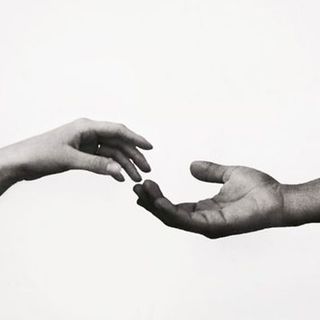
Why Childhood Memories Are Vivid for Some, Hazy for Others
How can two childhood friends remember the same moment so differently?

On my first day of preschool, when I was three years old, there was a little girl with pigtails wearing a white dress with small puffed sleeves, dotted all over with small red apples. I liked apples. And that is the story of how my oldest friend and I became friends.
Most of my memories of my childhood, many of which include her, are like that — snapshots, feelings, gists. She, on the other hand, can recount in detail, escapades that come back to me only in hazy form and emotion as she narrates. She can give precise descriptions of class activities I more or less assume happened, and remember the quirks of teachers whose names and faces I struggle to recall. (Yes, we’re still close friends; yes, we’re adorable.)
She remembers; I reconstruct. Which of us is the weirdo?
Neither. (Or, more honestly, both, but that’s a topic for another time.) Memory exists on a spectrum, or perhaps more accurately, across a very complex Venn diagram. While most of us tend to think of memory as a monolithic trait or skill, there are many, many different kinds of memory that overlap to form the sum of an individual’s life knowledge, a.k.a. autobiographical memory.
Related on The Swaddle:
Your Earliest Childhood Memories May Not Be Real
Two of the types of memory that go into one’s autobiographical memory are semantic and episodic memories. Autobiographical semantic memory is basically the facts of your existence — names, places, relationships, dates, etc. Think: who your parents are, who your Class IX teachers were, the address of your childhood home, the year you had your tonsils removed, the name of the song that changed your life. It’s like your own private, extended biodata.
Episodic memory, on the other hand, is your memory of life events. For instance, take this experience from Class VIII that my friend and I both remember: a team project on something related to satellite imagery for a computer class taught by a man with a bushy white beard. I remember she and I, along with two other close friends formed the team. I remember the project devolved into a huge fight, as three perfectionists clashed to the point that the only thing we had in common was our temporary loathing for the one peacemaker among us. I remember working on the project in the living room of one person’s home, where I retain a hazy impression of blue walls. And I assume we all got a passing grade of some kind.
By contrast, my friend remembers the topic of the report, the name of the teacher, conversations from that time, sequences of behavior by the individuals involved (I apparently rolled my eyes a lot), how many times we met to work on the project, the length of the final report, the marks we received, and of course — that it all occurred in Class VII, not VIII.
As we make episodic memories, we’re processing them in two different ways: verbatim and gist. Verbatim memories are accurate mental recordings of an event or experience. Gist memories are just that — gists, summaries and impressions that are influenced by mental connections to previous experiences, and which can, in turn, lead us to revise our memories of those past experiences. For most people, verbatim memories fade within a day or two. Gist memories, however, are retained for much longer and form most of our recollection of experiences and events. This is what creates the ‘fuzziness’ of memory — we’re remembering the essentials, and filling in the rest with context, earlier interpretations, and semantic assumptions generated from previous experiences and knowledge — and what allows for ‘false’ memories based on suggestions.
But some people have exceptional verbatim memory when it comes to the events of their life. Highly superior autobiographical memory (HSAM), also known as hyperthymesia, is characterized by an unusual number of extremely vivid personal memories. People with HSAM can recall, without conscious effort or mnemonic tricks, much of their lived experiences in detail, to the date and time, including events banal and recurring (teeth brushing, or the weather, say), as well as milestones (a graduation, for instance, or a world event). These ultra-vivid memories tend to date back to adolescence, at the earliest, and people with HSAM aren’t immune to childhood amnesia, i.e., the natural erasure of memories before age 3.
“My memory is like a library of VHS tapes, walk-throughs of every day of my life from waking to sleeping,” Nima Veiseh told the BBC in a 2016 feature on HSAM.
Their exceptional memory seems reserved for their personal life, however; they typically show no particular knack for rote memorization of knowledge, like memorizing a poem, or short-term memory, as in taking a dinner order. For some with HSAM, the recall is so involuntary it can spin out of control; when a memory is triggered, it can trigger another memory, and so on and so on, all as vivid as the last, which some people with HSAM report as distracting.
The causes of HSAM aren’t known; it’s an extremely rare condition. Research involving people known to have the knack has revealed some unique neural characteristics, but it’s not clear whether these brain wiring quirks are the result or cause of their ability. Instead, experts propose personality may make people more prone to dwelling on life memories and thus building memory as a skill to the point of exceptionalness. A project profiling the personalities of 20 people with HSAM found they scored unusually highly on two traits: fantasy proneness (that is, a disposition to imagine and daydream) and absorption (the ability to completely immerse yourself in all sensations and observations of an experience), reported David Robson for the BBC.
“The absorption helps them to establish strong foundations for a recollection … and the fantasy proneness means that they revisit those memories again and again in the coming weeks and months. Each time this initial memory trace is ‘replayed,’ it becomes even stronger,” Robson explained. “In some ways, you probably go through that process after a big event like your wedding day – but the difference is that thanks to their other psychological tendencies, the HSAM subjects are doing it day in, day out, for the whole of their lives.”
Whether or not my friend has HSAM, she certainly falls on the unusually-strong-verbatim-recall end of the spectrum, while I dwell solidly on the roughest-sketch-of-gist side of autobiographical memory. Both are normal functions of memory — and, luckily for us, complementary ways of reminiscing.
Liesl Goecker is The Swaddle's managing editor.
Related


BDSM Culture Can Make Women More Assertive In Work, Relationships
